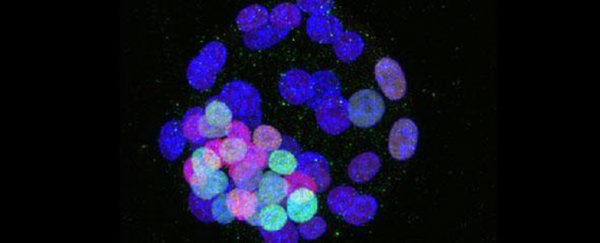Researchers in the UK have derived very early stage stem cell lines – called 'naive' pluripotent stem cells – from human embryos for the very first time.
The achievement, which is something scientists have been working towards for decades, could help us better understand how genetic conditions such as Down syndrome develop at the cell level, and create new kinds of treatments to promote healthy cell lines.
"Until now it hasn't been possible to isolate these naive stem cells, even though we've had the technology to do it in mice for 30 years – leading some people to doubt it would be possible," said researcher Ge Guo from the Stem Cell Institute at the University of Cambridge. "[B]ut we've managed to extract the cells and grow them individually in culture."
The advantage of naive pluripotent stem cells is that they're flexible compared to other kinds of stem cells used in scientific pursuits, with theoretically no restrictions on the kinds of adult tissue into which they can develop.
By contrast, unaltered embryonic stems cells (derived from fertilised egg cells) and induced pluripotent stem cells (reprogrammed skin cells) are already primed with instructions to differentiate into particular cell types.
Naive pluripotent stem cells derived from human embryos, on the other hand, don't contain these directions, meaning they could potentially offer a clean slate for biomedical therapeutic purposes.
"Naive stem cells have many potential applications, from regenerative medicine to modelling human disorders," said Guo. In terms of regenerative medicine, this could mean developing 'healthy' cell treatments for organs and tissues affected by conditions that impede their regular regenerative capacity, including the heart, brain, and pancreas.
Usually when an egg cell is fertilised by a sperm, it begins to divide and replicate before the embryo takes shape. As part of this process, embryonic cells cluster together and form a structure called the blastocyst, which comprises a number of different cell types vital to the ongoing development of the embryo, including naive cells that will go on to form the embryo's body.
What the scientists have succeeded in doing is removing these cells from the blastocyst early on the process – six days after fertilisation, and about a day after the blastocyst has started to form. By extracting the naive cells at this point, it ensures that they don't receive the genetic instructions that would prime their future development into particular, differentiated cell types.
According to the researchers, this technique – which is described in Stem Cell Reports – could be of particular help in researching conditions that develop due to an abnormal number of chromosomes.
While the human body usually contains 23 pairs of identical chromosomes – 22 pairs and a pair of sex chromosomes – this isn't always the case. Some children, such as those born with Down syndrome, have additional copies, which can cause abnormalities.
"Even in many 'normal' early-stage embryos, we find several cells with an abnormal number of chromosomes," said one of the researchers, Jenny Nichols. "Because we can separate the cells and culture them individually, we could potentially generate 'healthy' and 'affected' cell lines. This would allow us to generate and compare tissues of two models, one 'healthy' and one that is genetically identical other than the surplus chromosome. This could provide new insights into conditions such as Down's syndrome."
